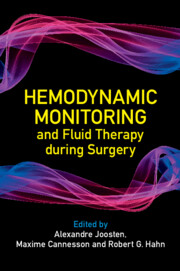Book contents
- Frontmatter
- Contents
- List of Contributors
- Foreword by Jean-Louis Vincent
- Preface
- Section 1 Hemodynamic Monitoring in the Perioperative Period
- 1 Overview of the Circulation
- 2 Invasive Hemodynamic Monitoring
- 3 Non-Invasive Blood Pressure Monitoring
- 4 Microcirculation and Mitochondrial Dysfunction
- 5 Cerebral Oximetry
- Section 2 Basic Science & Concepts in Fluid Therapy
- Section 3 Practical Use
- Section 4 Future Directions
- Index
2 - Invasive Hemodynamic Monitoring
from Section 1 - Hemodynamic Monitoring in the Perioperative Period
Published online by Cambridge University Press: 11 April 2024
- Frontmatter
- Contents
- List of Contributors
- Foreword by Jean-Louis Vincent
- Preface
- Section 1 Hemodynamic Monitoring in the Perioperative Period
- 1 Overview of the Circulation
- 2 Invasive Hemodynamic Monitoring
- 3 Non-Invasive Blood Pressure Monitoring
- 4 Microcirculation and Mitochondrial Dysfunction
- 5 Cerebral Oximetry
- Section 2 Basic Science & Concepts in Fluid Therapy
- Section 3 Practical Use
- Section 4 Future Directions
- Index
Summary
The aim of hemodynamic monitoring is to enable the optimization of cardiac output and therefore improve oxygen delivery to the tissues, avoiding the accumulation of oxygen debt, in the perioperative period. Instigating goal-directed therapy based on validated optimization algorithms has been shown to reduce mortality in high-risk patients and complications in moderate- to high-risk patients.
A number of devices are available to facilitate this goal. Devices that continuously analyze the arterial pressure waveform to calculate various flow parameters have been developed and validated. These devices have facilitated the introduction of hemodynamic monitoring to the wider surgical population, providing useful clinical information that enables the judicious use of fluid therapy whilst avoiding hypervolemia.
This chapter explores the role that hemodynamic optimization plays in perioperative care, describes some of the commonly used invasive hemodynamic monitors, and explains how to use the information produced effectively. Used correctly, any monitor can be useful to improve outcome if applied to the right population, at the right time, and with the right strategy.
Keywords
- Type
- Chapter
- Information
- Hemodynamic Monitoring and Fluid Therapy during Surgery , pp. 17 - 31Publisher: Cambridge University PressPrint publication year: 2024

